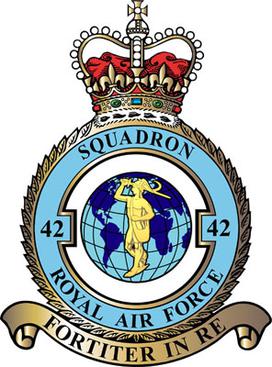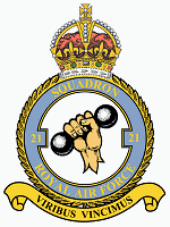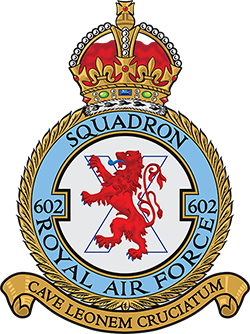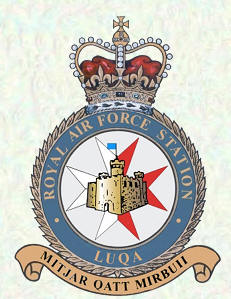
No. 1435 Flight is a Eurofighter Typhoon FGR.4 unit of the Royal Air Force, based at RAF Mount Pleasant, providing air defence for the Falkland Islands, South Georgia and the South Sandwich Islands. Permanently based in the islands, the aircrew and groundcrew from the UK are cycled through No. 1435 Flight, providing a 365-day, 24-hour alert.

Number 42 Squadron was a squadron of the Royal Air Force. It served during the First World War as an army co-operation squadron and during the Second World War in various roles. Between 1992 and 2010, it was the Operational Conversion Unit (OCU) for the Hawker Siddeley Nimrod MR.2, based at RAF Kinloss, Moray, until the Nimrod MR.2's retirement in March 2010. No. 42 Squadron disbanded on 26 May 2011.

Number 43 Squadron, nicknamed the Fighting Cocks, was a Royal Air Force aircraft squadron originally formed in April 1916 as part of the Royal Flying Corps. It saw distinguished service during two world wars, producing numerous "aces". The squadron last operated the Panavia Tornado F3 from RAF Leuchars, Scotland, in the air defence role, until it was disbanded in July 2009.

Royal Air Force West Malling or more simply RAF West Malling is a former Royal Air Force station located 1.6 miles (2.6 km) south of West Malling, Kent and 5.2 miles (8.4 km) west of Maidstone, Kent, England.

No. 603 Squadron is a squadron of the Royal Auxiliary Air Force, based in Edinburgh, Scotland. On reforming on 1 October 1999, the primary role of 603 Squadron was as a Survive to Operate squadron, as well as providing force protection.

No. 683 Squadron RAF was a photo-reconnaissance squadron of the Royal Air Force during the Second World War and from August 1950 to November 1953.
No. 691 Squadron RAF was an Anti-aircraft cooperation squadron of the Royal Air Force from 1943 to 1949.
The No. 341 Squadron also known in French as Groupe de Chasse n° 3/2 "Alsace", was a Free French squadron in the RAF during World War II.

No. 21 Squadron of the Royal Air Force was formed in 1915 and was disbanded for the last time in 1979.

No. 607 Squadron is an auxiliary squadron of the Royal Air Force. It was formed in 1930 as a bomber unit in the Auxiliary Air Force and changed in 1936 to the fighter role. It fought in that role during the Second World War in Europe and Asia. After the war, in 1946, the squadron reformed as a fighter unit. Awarded the title Royal Auxiliary Air Force by King George in 1947, 607 Sqn was disbanded with all the other flying units of the RAuxAF on 10 March 1957. It reformed on 5 January 2015, as a General Service Support Squadron (GSS).
No. 682 Squadron RAF was a photo reconnaissance squadron of the Royal Air Force during the Second World War.
No. 681 Squadron RAF was a photo-reconnaissance squadron of the Royal Air Force during the Second World War.
No. 203 Squadron RAF was originally formed as No. 3 Squadron Royal Naval Air Service. It was renumbered No. 203 when the Royal Air Force was formed on 1 April 1918.

No. 322 (Dutch) Squadron of the Royal Air Force was a fighter squadron during the Second World War.

No. 613 Squadron was an Auxiliary Air Force later Royal Auxiliary Air Force squadron formed on 1 February 1939 at the then new municipal airport at Ringway, nine miles south of Manchester. The squadron served at first in the army cooperation role, and later during the Second World War became a tactical bomber unit. After the war the squadron reformed as a fighter unit and as such flew until its last disbandment in March 1957.

Number 601 Squadron is a squadron of the RAF Reserves, based in London. The squadron took part in the Battle of Britain, during which the first Americans to fly in World War II were members of the squadron.
No. 229 Squadron RAF was a squadron of the Royal Air Force, and is an officially accredited Battle of Britain Squadron. It became No. 603 Squadron RAF in January 1945.

602 Squadron is a Royal Auxiliary Air Force squadron. Originally formed in 1925 as a light bomber squadron, its role changed in 1938 to army co-operation and in 1939 to that of a fighter squadron.

Air Headquarters Malta was an overseas command of the Royal Air Force (RAF) during the Second World War. It was established on 28 December 1941 by renaming RAF Mediterranean under Air Vice Marshal Hugh Lloyd. Lloyd was named Air Officer Commanding in Malta on 1 June 1941.

Royal Air Force Krendi, also known as RAF Qrendi, was a Royal Air Force base located on the island of Malta, near the town of Qrendi. The station was officially inaugurated in 1941 as a diversion airstrip for the main operating bases such as nearby RAF Luqa. Other diversion airstrips similar in function to Krendi were located at RAF Safi and on Malta's second island of Gozo. Later, in November 1942, the British began basing fighter squadrons at Krendi. These remained until late 1943. After the war, the airfield was used as a tracking station and vehicle park, before falling into disuse.
















